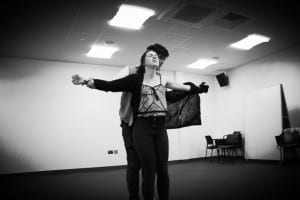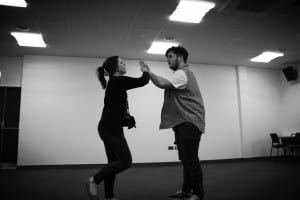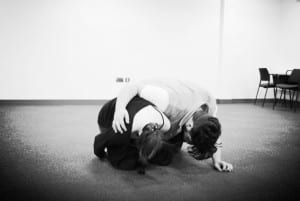After several weeks of researching, planning and exploring ideas with the Fill In The Blank team we have finally made a start on our debut performance ‘The Man Whose Memories Fell Out’.
In looking back at our manifesto we understood we wanted to rely on the body to speak for itself to tell the story. A company’s mission statement ‘declares in clear and concise terms the theatre’s purpose and key objectives’ (Downs, Ramsey and Wright, 2013).
Our theatre is visual.
Our theatre is universal.
Our theatre is innovative
Myself and Michael were given the opportunity to explore the loving relationship between the couple spiralling out of control after discovering the man has encephalitis. The duet was a chance for us to really explore the brutality the condition can have on a married couple. We started by creating a sequence of movements incorporating different levels through lifts and floor work. Once we had the routine down, we explored what impact speed would have in portraying the difficulties the wife faces day by day . By repeating the routine three times, we were able to start at a considerably slow pace and then speed up each time we performed the sequence. The repetition of the movement enabled us to show how the wife’s life is now a vicious cycle of repeated gestures between her and her husband since he lost his memory. Through facial expression I was able to show love and compassion when he embraced me, to the grieve and heartache when he lost sight of who I was.

Initially the duet was rehearsed with no music, however when researching encephalitis, we found a particular couple’s story which inspired us to create our own text that we could record as a voice over to accompany the movement. After several attempts at recording our two individual voices with a set script written by our director, we felt as a group that the voice over needed more depth to it than just speeding up. Our sound designer decided to record the other female voices, speaking certain parts of the text to add to the confusion of the wife’s movements. This illustrated the tension and frustration within the wife’s mind beautifully and also gave the audience a narrative to follow without loosing what was being told through the body. Similar to Frantic Assembly we wanted the lines of creativity to begin to merging as one. As Scott Graham states:
‘a successful production for us will be one where it is hard to distinguish what came first between, say, words and movement or movement and music’ (Graham and Hoggett, 2009, 8)
Works Cited:
Dale, A. (2015) Duet [Taken] 16 April 2015.
Downs, W., Ramsey, E and Wright, L. (2013) The Art of Theatre: Then and Now. Boston: Cengage Learning.
Graham, S. and Hoggett, S. (2009) The Frantic Assembly Book of Devising Theatre. Oxon: Routledge.

